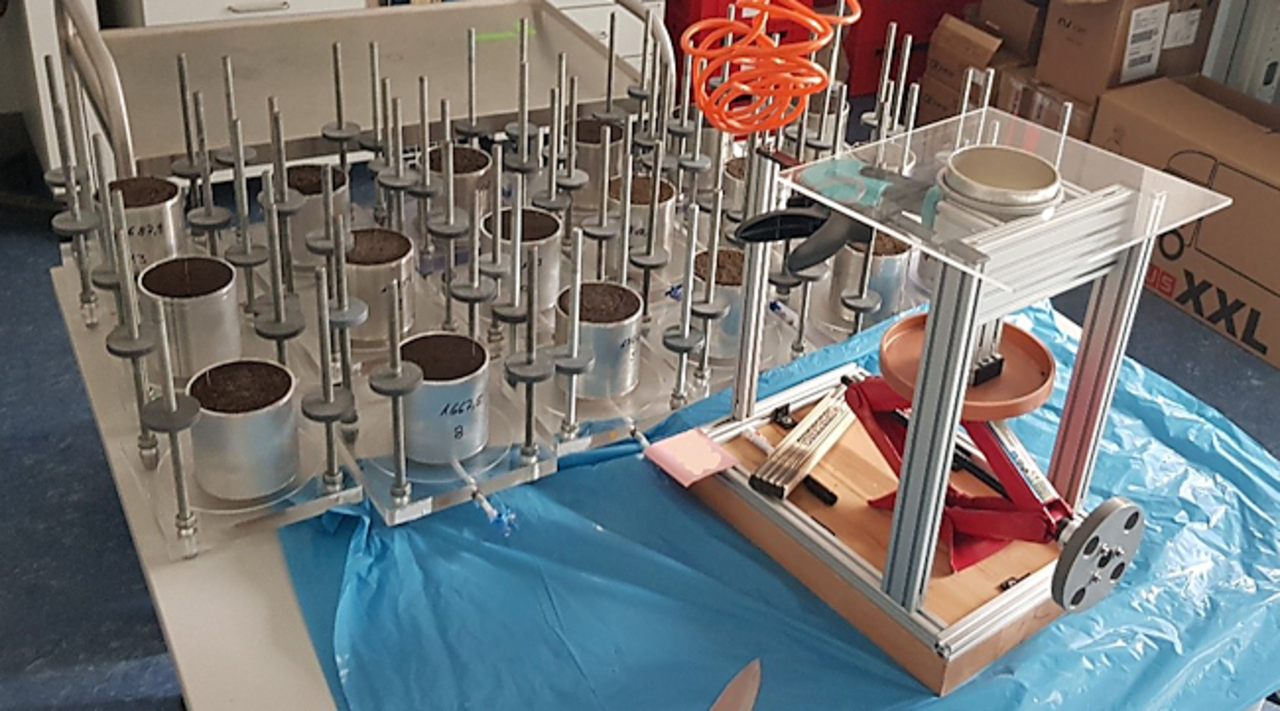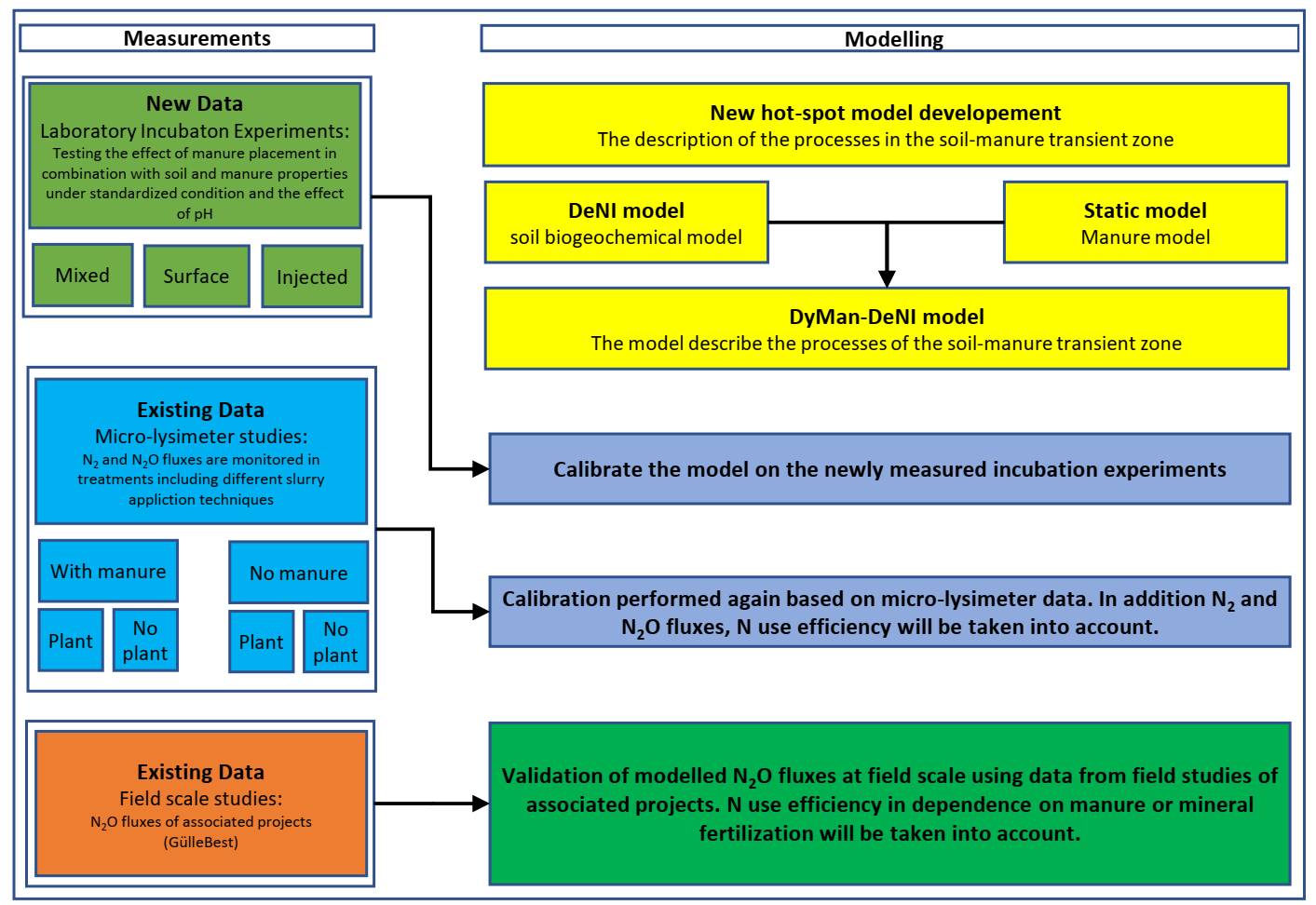Project
Modeling N2O and N2 fluxes from organic fertilization

Modeling the impact of liquid organic fertilization and associated application techniques on N2O and N2 emissions from agricultural soils
Prediction of N2O and N2 fluxes from liquid organic fertilization will be improved by further development of models taking into account spatial dynamics of relevant processes.
Background and Objective
Fertilizing agricultural soils with liquid manures affects gaseous N losses to the atmosphere including N2O, N2, NH3 and NO as well as nitrate leaching. These emissions impair nitrogen use efficiency of crops and contribute to the greenhouse effect and stratospheric ozone destruction and pollution of aquatic resources. Their extent depends on the complex interaction between manure application techniques and properties of manures and soil. Whereas the type of manure effects on N transformations including gaseous fluxes is known, their prediction is still poor because previous investigations mostly excluded N2 flux quantification and current models do not consider the process dynamics arising from the spatial dispersion of manure components within the soil.
Our proposal addresses the general question, how liquid manure fertilization and its application mode (surface, injected, incorporated) impact N2O and N2 fluxes from agricultural soils, how their optimization could mitigate N2O and NH3 emissions while maintaining crop yields and how models would have to be improved to find these relevant answers. We will address this by targeted experiments to quantify N2, N2O and NO fluxes as well as gross rates of mineralization and nitrification of soil-manure systems under controlled conditions and using results to evaluate and improve models.
The overall aim of the project is to test and improve the ability of biogeochemical models to predict effects from liquid manure fertilization on N2O and N2 fluxes. We will use existing and new data on the basis of conceptual understanding where we target mechanisms that are until now not properly accounted for in the models.
Specific objectives are
- Compile existing data-sets and collect new data-sets suitable to test and calibrate existing and improved models.
- Investigate the effects of fertilization with liquid organic manures under varying pH and using different application techniques on N-transformations, N2, N2O and NO fluxes and elucidate the respective control factors.
- Improve and calibrate the nitrification, denitrification and decomposition sub-models for better modelling of liquid organic manure effects.
- Apply and validate the model with existing data sets from field
- Test GHG mitigation strategies based on optimized slurry fertilization using the calibrated and improved models.
Target Group
Scientific community
Approach
The first part of the work program includes laboratory experiments to compare the effect of different techniques of liquid manure application in combination with soil and manure properties on N2O and N2 emissions. This will be a basis to develop or improve and test empirical and process-based models.
The second part of the work program includes model development, improvement and testing based on the experimental data. We will first test and calibrate an existing conceptual “Static Model” that takes into account spatial distribution of manure components. This is to evaluate the potential usefulness of its conceptual approach for implementation into mechanistic numerical models. For the latter we will implement the ability to model gradients due to organic hotspots using algorithms of the “Static Model”. We plan to use this concept and integrate it with other process-based models (DeNi model and/or DNDC). The selected process-based models could simulate the effects of slurry application techniques dynamically by their ability to predict the interaction of respiration, diffusion, mineralization, pH and their impact on nitrification and denitrification over time. Both models are designed to model bulk soil conditions and transport only in relation to soil-atmosphere gradients.
The last part of the work program will evaluate manure effects in arable agriculture and potential greenhouse gas mitigation options using improved models. Simulations will be designed for testing assumptions of realistic environmental conditions in order to predict manure effects on N2 and N2O fluxes in various soil and climate conditions and in dependence of manure properties.
Our Research Questions
- Are anaerobic processes and N2 and N2O emissions enhanced by concentrated distribution of slurry compared to homogeneous distribution?
- Are N2 and N2O emissions reduced by factors increasing the initial uptake of degradable volatile solids into the soil matrix?
- Are current biogeochemical models underestimating slurry-induced N2 and N2O fluxes due to the lack of routines to take non-homogenous slurry distribution into account?
- Can these shortcomings be solved by implementing additional compartments for slurry fractions?
Results
Laboratory work of the first funding phase is completed (see first publication under "Projektverknüpfungen zu Publikationen, Projektbewirtschaftung und Stellenangeboten", a second publication is under reveiw). Development and application of the models is ongoing. First findings have been reported as part of two overwiew papers (both submitted, one already accepted). A proposal for extending the project for further 3 years was submitted to DFG in due time. The final report of the first funding phase is part of the proposal and is thus not available to the public.
Thünen-Contact

Involved Thünen-Partners
Involved external Thünen-Partners
- Aarhus University
(Aarhus, Tjele, Dänemark) -
Norwegian University of Life Sciences
(Ås, Norwegen) -
Justus-Liebig-Universität Gießen
(Gießen, Deutschland)
Funding Body
-
Deutsche Forschungsgemeinschaft (DFG)
(national, öffentlich)
Duration
6.2019 - 1.2024
More Information
Project funding number: WE 1904/14-1
Project status:
finished

![[Translate to English:] [Translate to English:]](/media/_processed_/6/4/csm_titel_CO2Kampagne8_afeea2273e.png)
![[Translate to English:] [Translate to English:]](/media/_processed_/4/1/csm_titel_93px_CO2Kampagne8_9b0f3354d4.png)






